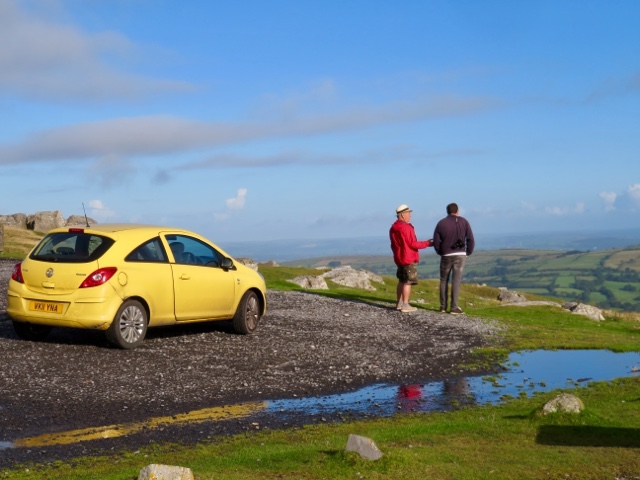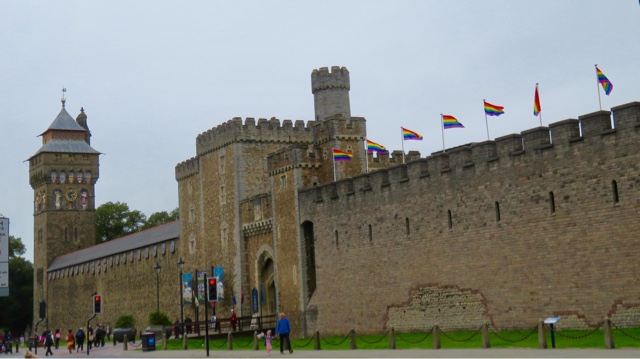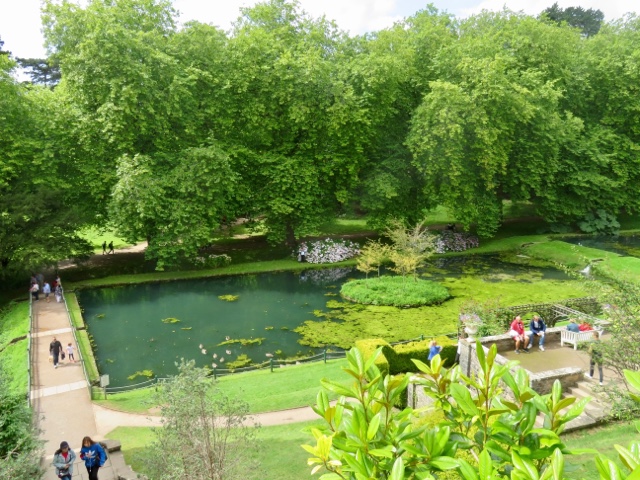While in this part of Wales we were hosted by Ray's brother John and his wife Liz who treated us like family and made us feel very welcomed in their lovely home.
Here is a picture of four of us at the local pub...
Speaking of their local pub we also went there for Sunday roast which is a very traditional meal in Wales...
Your choice of beef or pork served with roasted potatoes and Yorkshire pudding with loads of tasty vegetables on the side and my favourite being that it was smothered in gravy!
John also got us up early one morning to visit the Black Mountain which is just above their village...
The morning was chilly but clear and the views were again awesome...
Don and John admiring the view and talking about the history of the area...
It is more barren than the other side of the mountain range...
It had great walking trails that take you over the mountains...
With lots of room for grazing sheep...
There was also the remains of a limestone quarry where men had worked for many years under very difficult conditions and so a little history lesson...
Life was hard for the small farmers and labourers in this part of Wales and as a result there was an uprising called the Rebecca Riots....
" The Rebecca riots took place in the rural parts of west Wales, including Pembrokeshire, Cardiganshire, and Carmarthenshire, in 1839-1843. They were a series of protests made by tenant farmers against the payment of tolls (fees) charged to use the roads. Turnpike Trusts, or groups of businessmen, owned most of the main roads. These men fixed the charges and decided how many tollgates (turnpikes) could be built.
During the riots, men disguised as women attacked the tollgates. They called themselves ‘Rebecca and her daughters’. This is most likely to be after a passage in the Bible where Rebecca talks of the need to ‘possess the gates of those who hate them’ (Genesis XXIV, verse 60). People at that time knew the Bible well.
Tolls were a big expense for small farmers, who used the roads to take their crops and animals to market, and also to collect lime (a chalky mineral). Lime was used to improve the quality of the soil so farmers could grow better crops. It could cost as much as five shillings (25p) in tolls to move a cart of lime eight miles inland. The people of west Wales did not want to pay to use their roads and thus the uprisings began."
And of course there wouldn't be a view anywhere in Wales without a castle on the distant hill...
We did manage a rare picture of us together on this beautiful morning
And then we were off to Cardiff, the capital city of Wales. Cardiff has a population of approximately 350,000 and is the largest city in Wales.It is a port city on the south coast of Wales where the River Taft meets the Severn Estuary.
There is lots of green space and parks in the city center especially along the banks of the river...
Many well tended flower beds...
This woman was lying in the circle of stones which are seen all across Wales, some are said to be burial sites or places of ritual and many are very old...
Everywhere there were people out enjoying the walking paths and the beauty of the parks...
Cardiff is a very walkable city and we stayed in an AirBnB about 10 minutes walk to the Center
Pedestrian walkways everywhere...
The Welsh flag is also seen everywhere, it is very distinctive with a red dragon in the middle.
There is a medevial castle dating from the 11th century located right in the Center of the city...
Pubs on every corner...
On Saturday night we went downtown to experience the nightlife...the evening was warm and the crowds were out...
Lots of groups of women in hen parties were out that night as well...a hen night is a party for a woman who is getting married to which only women are invited ..
We felt old that night as we went in some pubs that were way too loud and crowded for us so we left for a more traditional pub with old men and rugby players there...
This old guy was leading songs at his table to the amusement of the rest of the pub...
Another day we took the water bus down the river to Cardiff Bay...
This area is very well developed with lots going on there and many people enjoying the sights...
Sailors passing by...
Coming into the bay with a view of the Parlimemt buildings to the right...
Very busy area with many restaurants and attractions
Their seat of government is called The Senedd and is housed in a very beautiful building with art exhibits and beautiful public space.
One of the exhibits was " Poppies...the Weeping Window", comprising of several thousand handmade ceramic poppies paying tribute to the fallen in WW1. It was quite stunning...
On the only sunny day we had we took the bus to a small community about 30 minutes outside Cardiff called St.Fagans which hosts the National Museum of History. It is an open air museum chronicling the historical lifestyle, culture, and architecture of the Welsh people.
It consists of more than forty re-erected buildings from various locations in Wales, and is set in the grounds of St. Fagans Castle, an Elizabethan manor house.
Admiring the stone pigsty...we always thought pigstys were dirty but apparently pigs were highly prized animals on the farm and were given comfortable accommodations!
This roundhouse was built as a replica of one found on the island of Anglesey in north Wales. It dates to some 2000 years ago.
Part of a restored village...
This museum was free so there were lots of families with children there including these two cuties...
Cottage gardens...
Inside one of the old cottages
St Teilo's church is believed to have been built during the late 12th or 13th century on the site of an earlier Celtic church.
Our final walk through we're the gardens of the Manor House...
They were so green....
The manor house...we couldn't go inside because of a wedding reception
This museum is an excellent way to learn about Wales as well as enjoying a day outside in the beautiful surroundings.
We are now finishing our brief trip to this wonderful country, so full of natural beauty and friendly people but before we do I need to mail my postcards to our grandchildren. We send them one from each of the countries we visit and hope it inspires them to become travellers as well. We have learned so much from every trip and hope to be able to travel for many years to come!
Now off to Dublin to meet Dawn!















































Hi Debbie. Love the blog, very complementary of Wales, you paint a lovely picture. About the standing stones- I'm not sure about the ones in Cardiff you saw, every year we have the National eisteddfod, which is in a different town each year. Whenever a place hosts the National Eisteddfod, a small stone circle is built to commemorate the event. Again I'm not sure about these particular ones and maybe someone better qualified may correct me on the above.but I'm sure I'm correct. Anyway off I go to read about your other travels. P.s. Should have warned you about the hen dos, although I do find they add a bit of colour and amusement whilst you eat or drink in the city centre
ReplyDeleteThanks for that information. We saw similar stones in Fishguard and our host gave us the same information as you. So you are most likely correct!
DeleteWe both loved Wales...her beauty and her people!
Hope to see you either back here, in New foundland or Toronto in a couple of years.
DeleteStanding stones: https://en.m.wikipedia.org/wiki/National_Eisteddfod_of_Wales
ReplyDeleteHistory of Welsh Flag - y" ddraig goch" : http://www.bbc.co.uk/wales/history/sites/themes/flag.shtml
ReplyDeleteWonderful blog. It could be used by the Welsh Tourist Board ! You obviously had a great time, and it was good to meet you briefly in the local pub near John's house.
ReplyDeleteThanks Gerry! Glad you enjoyed the blog! We truly loved Wales!
Delete